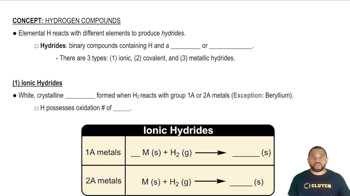Here are the essential concepts you must grasp in order to answer the question correctly.
Diborane Structure
Diborane (B2H6) is a compound consisting of two boron atoms and six hydrogen atoms. Its unique structure features two boron atoms bonded to each other, with four of the hydrogen atoms forming terminal bonds and the remaining two hydrogen atoms bridging the boron atoms. This arrangement leads to a three-center two-electron bond, which is crucial for understanding the bonding characteristics of diborane.
Recommended video:
Hydridic Hydrogen
Hydridic hydrogen refers to hydrogen atoms that behave as hydride ions (H-), meaning they can donate electrons and participate in bonding as an anion. In diborane, the bridging hydrogen atoms are described as hydridic because they contribute to the electron-deficient nature of the boron atoms, allowing for the formation of stable bonds despite the overall electron deficiency of the molecule.
Recommended video:
Electron Deficiency
Electron deficiency is a term used to describe molecules that do not have enough electrons to satisfy the typical bonding requirements of their constituent atoms. In diborane, the boron atoms are electron-deficient, which is why the hydridic hydrogen atoms play a critical role in stabilizing the structure by providing additional electron density, thus allowing the molecule to maintain its integrity despite the lack of a full octet around the boron atoms.
Recommended video:
 Verified step by step guidance
Verified step by step guidance

